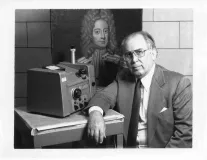Obituary: Robert L. Feller
Submitted by Kate Smith on 25 Oct 2018

By Paul Whitmore
The art conservation world lost a towering figure with the passing on August 3, 2018, of Dr. Robert L. Feller in Pittsburgh, PA, at the age of 98. Dr. Feller, Bob to his friends, devoted his life to providing the scientific research essential to the advancement of conservation practice. He was a pioneer and the leading practitioner of the emerging discipline of art conservation science research.
Bob found his way into conservation when he assumed the newly created position of National Gallery of Art Fellow at the Mellon Institute in Pittsburgh in 1950, and it was in that laboratory in Pittsburgh (and in its later incarnation as the Research Center on the Materials of the Artist and Conservator) where he spent his entire career until his retirement in 1988. His work changed the practice of conservation, leading to the widespread adoption of stable polymers such as Acryloid/Paraloid B-72 and of ISO Blue Wool standards which are now used as dosimeters for light exposure and elucidating the risks to material damage from light exposure, or when circumstances dictate, during conservation light bleaching. His writings have become definitive reference works on artists’ pigments, picture varnishes, color and fading, and accelerated aging. The clarity of his writing reflects his commitment to teach what he had learned to conservators and other researchers. His most enduring legacy may simply be the example that he set, showing the world how one can understand past changes in materials and can then reasonably forecast future changes through thoughtful, rigorous scientific research. Bob also understood the importance of translating that understanding into knowledge and tools that conservators could use. Caroline Keck always said Bob Feller was the scientist who most respected and truly collaborated with practicing conservators to find the best materials and approaches.
Beyond his scientific contributions, Bob was also a leader in the establishment of conservation as a profession. He was President of the International Institute for Conservation (IIC)-American Group and was a founding board member when that group became the American Institute for Conservation (AIC). He served as chairman of the International Council of Museums - Conservation Committee, and President of the National Conservation Advisory Council in the USA. For his contributions to the field, Bob was awarded honorary membership in AIC and their University Products Award. He was also granted the AIC Lifetime Achievement Award, which was named in his honor for all subsequent recipients. The IIC conferred on Bob honorary fellowship and presented him with the Forbes Prize. Bob was also honored as a recipient of the Pittsburgh Award from the American Chemical Society in recognition of his service to chemistry and humanity.
The profession of conservation has lost a great scientist, teacher, and leader, but we have also lost a genuinely great man. All who knew Bob Feller will testify to his warmth and his humor, his humility and his old-fashioned class. And perhaps his defining characteristic, in his professional and personal relations, was his heartfelt respect for others. His greatness as a teacher, as a leader, and as a person was born from his dealing with people as equals; people who he sought to help and teach, and from whom he could also learn through their own wisdom and experiences. It is the loss of a man having these qualities, more than simply his scientific abilities,that will be felt most deeply.
Written with consultation from Joyce Hill Stoner (Edward F. and Elizabeth Goodman Rosenberg Professor of Material Culture, University of Delaware) and the FAIC Oral History File housed at the Winterthur Museum, Library, and Archives.
Paul M. Whitmore
Lab head
Institute for the Preservation of Cultural Heritage
Yale University